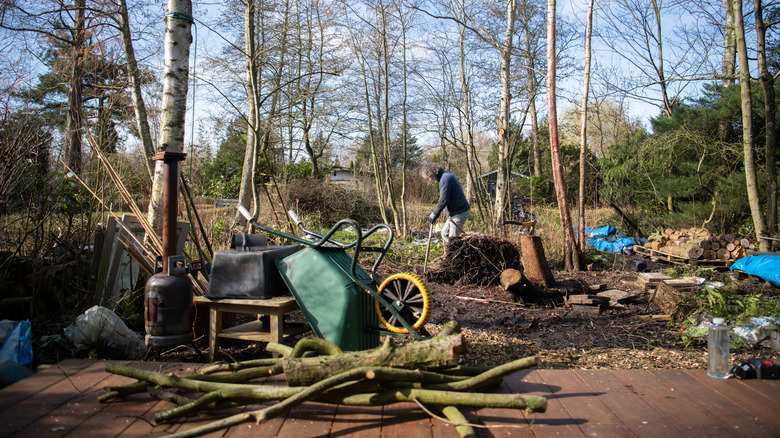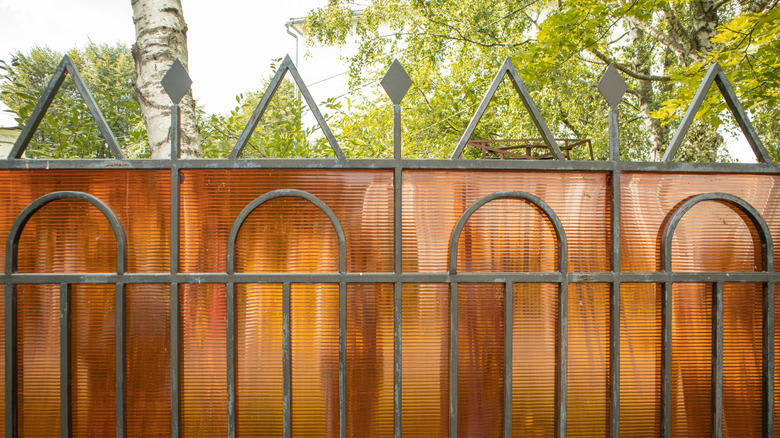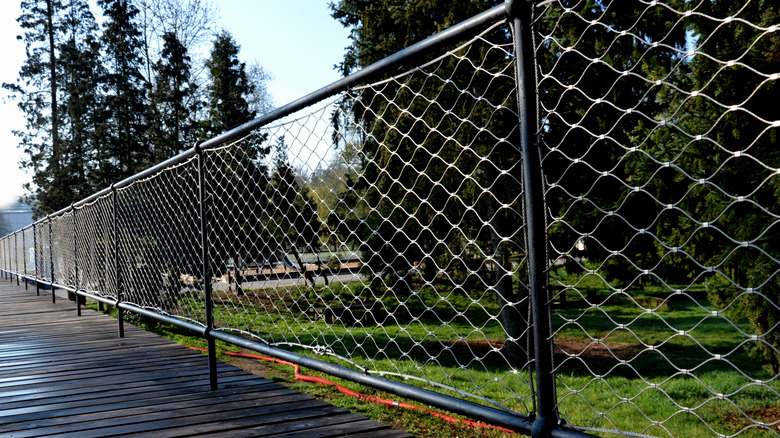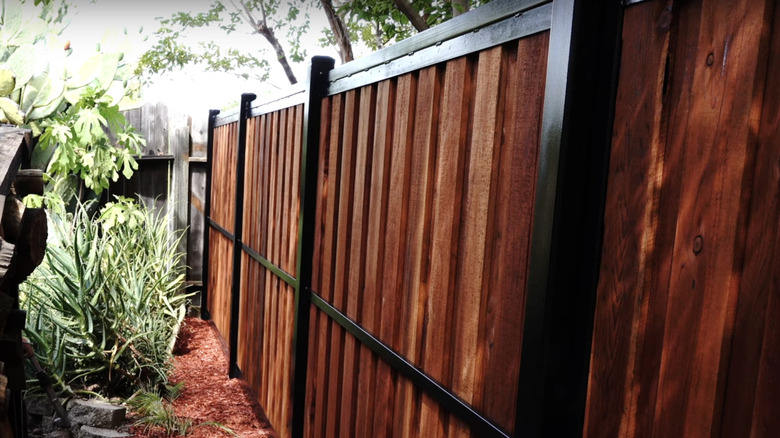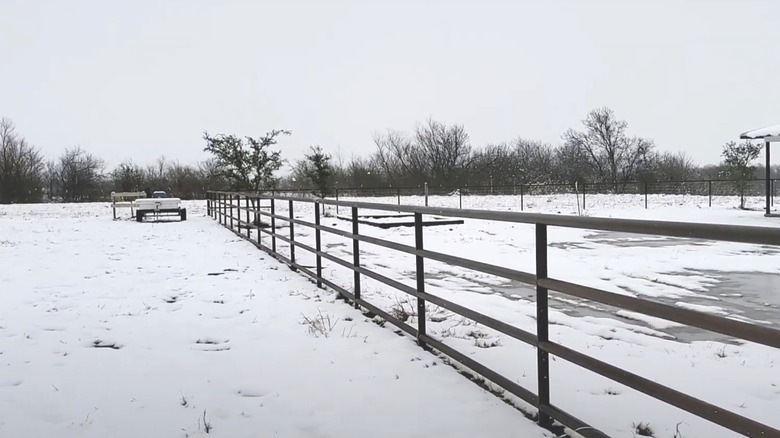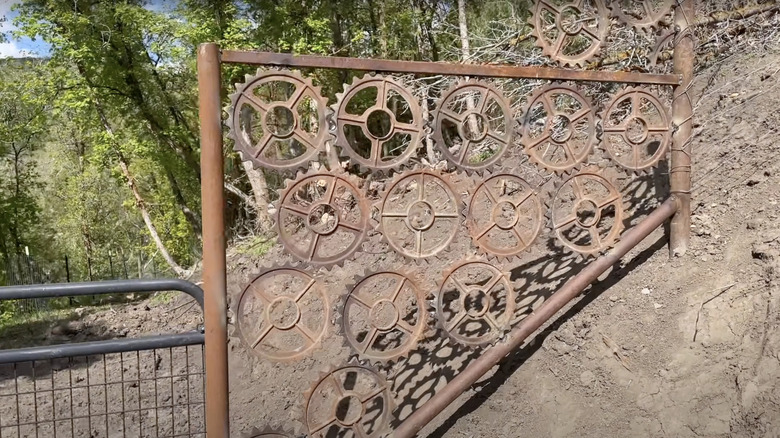Pipe Fence Ideas To Upgrade Your Outdoor Space
We may receive a commission on purchases made from links.
Cost-effective ways to add a fence to your property are top of mind during a backyard renovation. Who doesn't want to save the majority of their budget for that luxury outdoor kitchen build? Alas, one mistake everyone makes when installing a fence is keeping the budget under control. You won't have that problem with pipe fencing, which costs, on average, just $10 to $15 per square foot (excluding installation labor). And while pipe fencing most often graces farm fields or borders extensive rural properties, it can add rustic charm and save you precious grill-buying dollars in your urban or suburban setting, too.
Cold rolled (also called mild) steel or schedule pipe (the most common is Schedule 40) are most often used for round pipe fencing. They're known in the industry as oil field or drill pipes. These pipes are made from galvanized, stainless, or powder-coated steel, and which you choose depends on the look and longevity you need. Some suppliers also provide square and rectangular pipes (or tubing) for fencing, which they claim are stronger and easier to install than their rotund counterparts. This variation of the pipe fence is often used in decorative or residential renovation projects but also has a place in rural settings.
These fences run the gamut of material combinations — polycarbonate and corrugated iron sheeting, chain-link, cattle mesh, stretched steel wire, and wood planks, just to name a few. What's more, the designs aren't limited to the bar-and-post style you see on ranches. As you'll see below, you can even find pipe fences made with junkyard finds for a truly low-cost yet unique fence build.
Finish your pipe fence with metal or plastic sheets
Corrugated sheet metal is often mounted to pipe fence frames. To make this project an easy DIY outdoor upgrade, use square or rectangular tubing for your frame; the steel sheets sit nicely flush with it. Pre-drilling screw holes in your sheets and posts using a drill bit designed for metal also helps. Alternatively, use self-tapping screws, which feature tips that drill into the metal like a bit. While privacy is near-total with metal sheeting, this fence can shadow a yard, especially if it's tall.
TikTok content creator @life_of_kiley needed to fashion an important addition to the cheaply built pipe and steel wire fence he'd already built: a front yard privacy fence. He found some perforated panels made from an architectural steel alloy called Corten or weathering steel — which is designed to rust, creating an authentic, rough-and-ready patina — and secured those to the existing pipe fencing, along with a latching gate crafted from the same material. Flat or corrugated perforated Corten metal sheets are available by quotation from select American suppliers. The perforations in the sheets let in some natural light while still concealing the home from prying eyes.
Considering the amount of privacy they provide, polycarbonate sheets let through a great deal of light. Polycarbonate is a type of thermoplastic that can be transparent or opaque, and is robust and shatterproof, making it ideal for use as a privacy fence in a residential backyard. That said, drilling into a polycarbonate sheet is notoriously tricky. As with sheet metal, you must pre-drill the holes for screws or fasteners.
Fitting chain-link to a pipe fence keeps pets in and your yard secure
A classic chain-link fence consists of a pipe fence paired with some type of mesh. All you need are these two construction materials, some concrete and fence clips, a few tools (a bucket, winch, mortar hoe, digging bar, and an electric drill), and some human power. So, this is arguably one of the easiest pipe fence ideas to DIY if you want to upgrade your outdoor area. It's also a highly flexible option; all that's determining the height and length of your fence are the pipe lengths and the available chain link mesh dimensions.
Traditional chain-link mesh features diamond-shaped holes, but another style, called woven wire or windowpane wire mesh, has square holes. This sturdy mesh style, which is often used in livestock fencing, is trending in country neighborhoods across the USA, where homeowners want to channel a little of the nearby farm life into their suburban or hobby farm property.
You can change up the hole size of the mesh or add balls, finials, or caps to the posts to take your fence from utilitarian to decorative. If you find the chain-link or mesh looks too industrial for your aesthetic vision or doesn't provide enough privacy, cover it with artificial leaf hedge screening. One E&K Sunrise 4 x 14 Foot Laurel Leaf Privacy Fence panel in dark green costs about $37. This cheap and cheerful product is fast and easy to mount on your own: simply secure the sections to your fence using pliable galvanised wire or zip ties.
Mount timber planks to pipe posts for a more robust wooden fence
Here's a wood fence idea for a stylish and private yard you might never have thought of: keep the pickets and horizontal rails, but replace your wooden fence posts with steel pipe posts. This way, you get the classic look of a natural timber fence while reducing all the maintenance — staining and checking for rot — that comes with wood. If you choose galvanized steel pipe, it will develop an attractive patina as it ages. Steel pipe posts are also cheaper and easier to get into the ground than those made from wood, and they won't burn in a fire. They flex slightly in high winds or when pushed, ensuring your fence can withstand storm conditions or hefty nearby yard work without toppling.
Key to crafting a sturdy pipe and wood fence lies is the steel-to-wood fence bracket. They comprise a loop that slips over the vertical pipe post and have screw holes to secure them to the wood. You can even convert a chain-link fence into a wooden fence using steel-to-wood brackets! The only downside is they add substantially to your fence-building budget. For example, a set of 24 2 ⅜-inch SupConn Galvanized Steel Fence Post Brackets cost nearly $80 — screws not included. There are also two-piece brackets available, though some experts consider them more prone to failure than the one-piece version. Pair steel pipe posts with cedar, redwood, or preservative-treated planks. Don't like the look of round posts? Build a frame for your timber fence from square or rectangular steel pipe instead.
Enclose your rural property with a top rail pipe fence
Steel pipe is a go-to material for agricultural fences; you could even argue its where the pipe fence first originated. Visit a ranch or working farm, and you'll likely see these fences dividing fields or sectioning off buildings from livestock. The classic rural pipe fence consists of a 6- to 10-foot-long (minimum) horizontal brace or top rail, corner, gate, end, pull posts, and post caps. These fences are considered wildlife friendly: small critters pass through or over the open rails without getting tangled. Repurposed or new oil field pipe is a popular choice for this style of fence, mainly because it's strong and cheap. Oil field pipes can, however, be radioactive or magnetized. If you're worried, check any pipes you're planning to buy with a Geiger counter and magnet detector.
With a few exceptions, constructing pipe fences requires welding the posts to the rails, so if you don't have the experience or specialized equipment to tackle such a task, you'll need to enlist the help of a professional fence builder. An easy way to turn a plain steel pipe fence from stockyard- to backyard-worthy is by painting it with a rust-proofing finish — Walmart sells 10.25-ounce cans of Rust-Oleum Rust Reformer Spray Paint in black for about $10. More elaborate changes that may or may not require professional help include adding a custom monogrammed gate, curving the top rail, using square tubing, or drawing horizontal cables.
Use scrap yard finds as panels in a pipe fence frame
As mentioned, used oil field piping is regularly repurposed into fences in agricultural settings. But there are a lot more ways you can up-cycle scrap metal and other more creative materials if you think of the pipes as mere frames for creativity. On the more mundane (though still thoroughly environmentally friendly) side is affixing reclaimed sheet metal to a fence frame made from oil field posts and square tubing. You can't get more privacy for your outdoor space than that! In one particularly creative fencing project by YouTuber Shed House, stainless steel well casings — basically giant metal pipes — form the posts for a fence made entirely from scrap materials.
Now, on to even more creative ideas. You'll need welding equipment for this one: add personality to a simple square tubing fence frame by filling it with variously sized machinery cogs you picked up at the junkyard. In fact, any kind of large, flat steel item will work for this idea. Don't be afraid to rummage and let your imagination run wild. Other options include filling the frame with bamboo poles — the material is sustainable and out-competes steel and concrete in tensile and compressive strength, respectively. A 4 x 6 foot VEVOR Natural Rolled Bamboo Fence costs about $78. Embrace bamboo's natural tan hue or paint or stain the poles a color that matches your outdoor aesthetic. Installed a chain-link fence around your backyard? Create a mural — and some subtle privacy — by weaving old inner tires tubes through the mesh.
